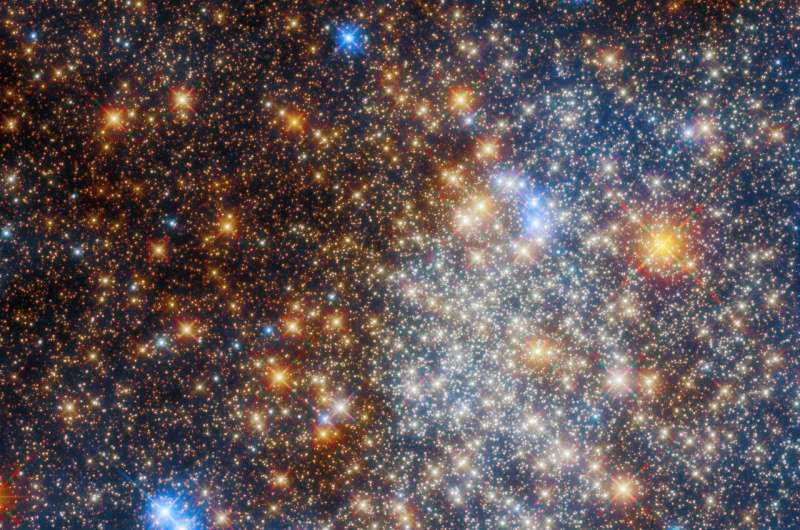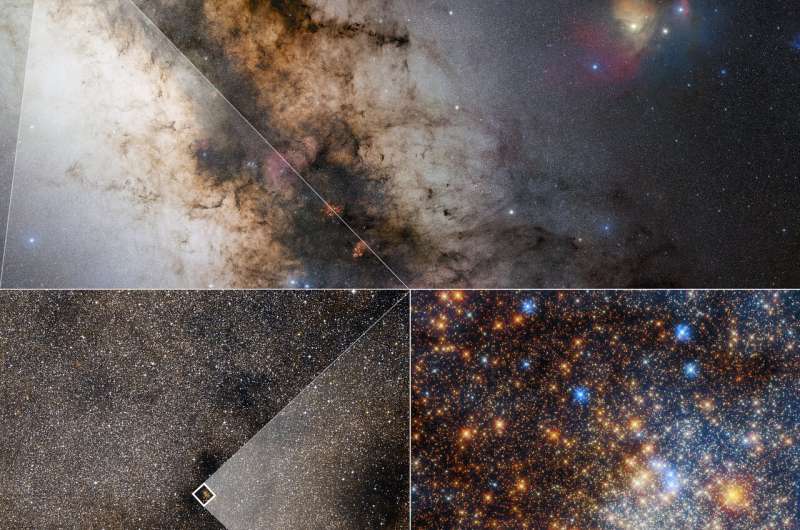This article has been reviewed according to Science X's editorial process and policies. Editors have highlighted the following attributes while ensuring the content's credibility:
fact-checked
trusted source
proofread
Hubble dispels dust to see glittering globular cluster Terzan 12

The glittering globular cluster Terzan 12—a vast, tightly bound collection of stars—fills the frame of this image from the NASA/ESA Hubble Space Telescope. The location of this globular cluster, deep in the Milky Way galaxy in the constellation Sagittarius, means that it is shrouded in gas and dust which absorb and alter the starlight emanating from Terzan 12.
This star-studded stellar census comes from a string of observations that aim to systematically explore the relatively few globular clusters located towards the center of our galaxy, such as Terzan 12, which is located about 15 000 light-years from Earth. Globular clusters are not uncommon in the Milky Way galaxy. Around 150 are known, mostly in its outer halo, and Hubble has revolutionized their study since its launch in 1990. However, examining clusters like Terzan 12, highly obscured by interstellar dust, is complicated by the resulting reddening of the light.
When starlight passes through an interstellar cloud it can be absorbed and scattered by particles of dust. The strength of this scattering depends on the wavelength of the light, with shorter wavelengths being scattered and absorbed more strongly. This means that the blue wavelengths of light from stars are less likely to make it through a cloud, making background stars appear redder than they actually are.
Astronomers refer to the color change caused by the scattering and absorption of starlight—appropriately—as reddening, and it is responsible for the vibrant range of colors in this image. Relatively unobscured stars shine brightly in white and blue, whereas creeping tendrils of gas and dust blanket other large portions of Terzan 12, giving stars a sinister red hue. The more dust that lies along our line of sight to the cluster, the more the light of the stars is reddened.

A similar effect is responsible for the spectacular rosy hues of sunsets here on Earth. The atmosphere preferentially scatters shorter wavelengths of light, which is why the sky overhead appears blue. As the sun sinks lower in the sky, sunlight has to pass through more of the atmosphere, which means more and more blue light is scattered and sunlight takes on a characteristically golden red hue.
Some of the stars in the photo appear starkly different in color to their near neighbors. The brightest red stars are bloated, aging giants, many times larger than our sun. They lie between Earth and the cluster. Only a few may actually be members of the cluster. The very brightest hot, blue stars are also along the line of sight and not inside the cluster, which only contains aging stars.
The reddening of stars usually poses problems for astronomers, but the scientists behind this observation of Terzan 12 were able to sidestep the effect of gas and dust by comparing the new observations made with the razor-sharp vision of Hubble's Advanced Camera for Surveys and Wide-Field Camera 3 with pre-existing images. Their observations should shed light on the relation between age and composition in the Milky Way's galaxy's innermost globular clusters, comparable to astronomers' understanding of the clusters spread throughout the rest of our galaxy.
Incidentally, the Terzan clusters suffer from something of an astronomical identity crisis: there were actually only 11 clusters discovered by the Turkish-Armenian astronomer Agop Terzan. The mix-up results from an error made by Terzan in 1971, when he rediscovered Terzan 5—a cluster he had already discovered and reported in 1968—and named it Terzan 11. Terzan attempted to fix his mistake, but the confusion caused has persisted in scientific studies ever since, astronomers eventually settling on the odd convention that there is no Terzan 11.
Losing and then rediscovering astronomical objects is surprisingly common, even in our own solar system. Minor planets such as asteroids and dwarf planets are often detected and then subsequently lost because their orbits cannot be determined from only a tiny handful of observations.
Provided by European Space Agency





















